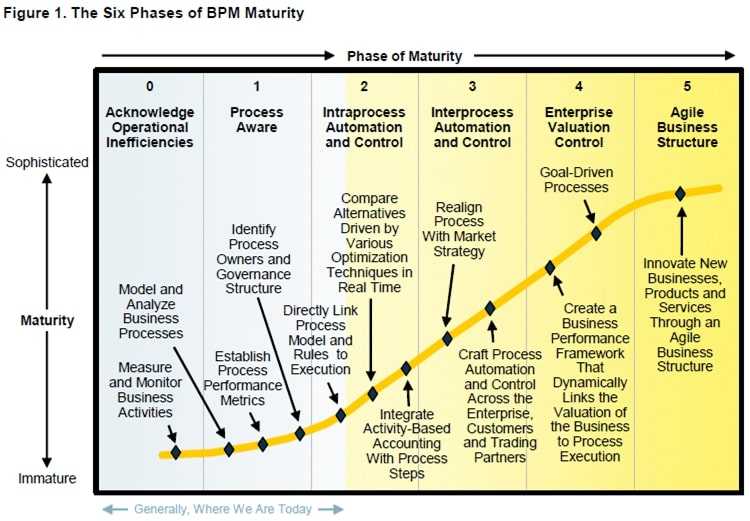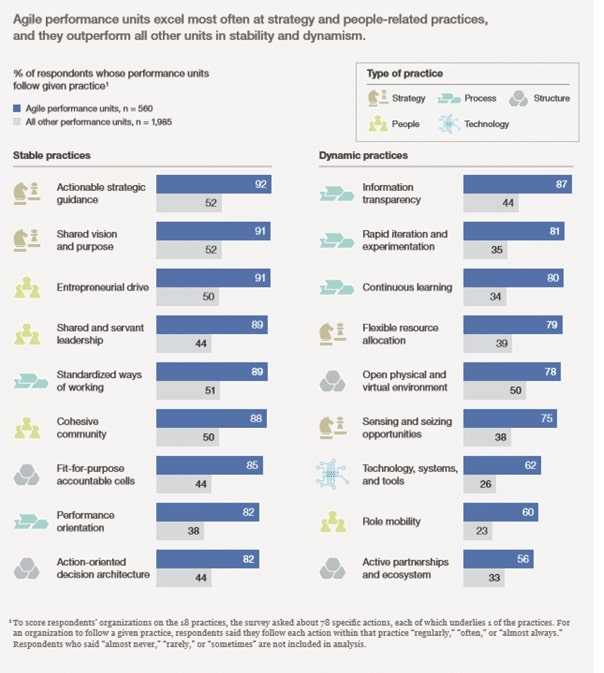Are you an agile, transformative business yet? Here’s why you should be.
Recently I came across this McKinsey article and one of the comments got me thinking:
Rapid changes in competition, demand, technology, and regulations have made it more important than ever for organizations to be able to respond and adapt quickly. But according to a recent McKinsey Global Survey, organizational agility—the ability to quickly reconfigure strategy, structure, processes, people, and technology toward value-creating and value-protecting opportunities—is elusive for most.
McKinsey – How to create an agile organization – 2017
The article reminded me of a similar study and I dug through my files and came across a Gartner study from ’08 called “Maturity Assessment for Business Process Improvement Leaders: Six Phases for Successful BPM Adoption”.
The curious thing is that both reports are essentially describing the same objective – how to move an organization toward an agile business structure. With 10 years separation between their original publish dates, the timespan alone indicates the relative difficulty of moving toward the “agile” objective.
While it goes without saying that the “disruptors”, “digital natives”, or “agile entrants” like Apple, Amazon, and Uber have gotten all the press in recent years for transforming and disrupting multiple industry segments – what does Business Process Maturity or “agility” mean to most small or medium businesses (SMBs)?
Here’s the answer: digital transformation (the adoption of a technology platform) that is scalable, functionally unified, and delivered with powerful process workflow tools is mandatory to survive in today’s business landscape.
Many respondents say their companies have not yet fully implemented agile ways of working, either company-wide or in the performance units where they work, though the advantages are clear. Respondents in agile units report better performance than all others do, and companies in more volatile or uncertain environments are more likely than others to be pursuing agile transformations.
McKinsey – How to create an agile organization – 2017
Why are these companies in “volatile environments” pursuing transformation with such vigor? In a separate study, McKinsey found that on average, greater than a full one-third of any given companies’ total revenues is at risk to loss or cannibalization due to new market entrants or other digital market forces.
As digitization continues to progress, its expected effects on revenues seem pronounced. When respondents were asked how much of their companies’ revenues would be at risk in the next three years if those companies took no further action to address digital pressures, they estimated that almost one-third could be lost or cannibalized.
Digital reinventors are at least twice as likely as traditional incumbents to report modifying their long-term strategies in response to digital-related changes. And when asked about specific actions taken to address digitization, the reinventors are much more likely than their peers to have launched new businesses and to have built new digital business models for their core businesses. Most notably, they are almost seven times more likely than their traditional counterparts to have fully digitized their core business models.
McKinsey – How digital reinventors are pulling away from the pack – 2017
Over 30% of total revenue at risk? That’s a big number! And it got me thinking about the Gartner Business Process Maturity (BPM) curve. If a Phase 5 Agile Business Structure is the goal – what impact does digital transformation have on an organization’s ability to move across the phases of process maturity?
Again the answer was in the interdependent material from these reports – adopting a digital strategy and platform – NOW– is critical because the slope of the BPM curve is only going to get steeper –as new entrants leverage more and more sophisticated technologies:
The curve embedded in the BPM maturity model represents the amount of effort and subsequent benefit that will accrue in each phase. As you approach the more advanced phases, the steepness of the curve shows that more work is required, but more return value is expected. This is a hallmark of maturity: Wisdom comes from investment, and wisdom begets increased benefit.

Gartner: Maturity Assessment for Business Process improvement Leaders: Six Phases for Successful BPM adoption
As “digital natives” (like Uber or Amazon) engage a market – or incumbent players adopt new digital business models and/or technology – the BPM curve gets steeper. Absent a technology platform allowing your organization to RAPIDLY adapt business processes, efficiently harness all market engagement channels (e.g. eCommerce integrated with traditional selling channels), and deliver operational clarity across departments; movement up the maturity curve is impossible. And collection of the monetary benefits of doing so becomes increasingly more difficult.
Among the dynamic practices, process—and information transparency, in particular—is a strength for agile units. Within transparency, for example, 90 percent of agile respondents say information on everything from customers to financials is freely available to employees. Among their peers in other units, only 49 percent say the same.

McKinsey – How to create an agile organization – 2017
So, the evaluation of new technology platforms isn’t simply about managing a chart of accounts, closing the books each month, or cycle counting inventory – it is about positioning your organization for process agility as a matter of survival. When Amazon comes for your industry segment, or we read about a new disruptor entering an industry – will you be ready to for the challenge? Will you be able to adroitly adjust operational business processes, data access for all personnel, and sales and procurement channels to meet the threat? Or, will you be stuck trying to implement new systems to enable those processes or worse, dealing with obsolete or manual systems and practices that block adaptation?
If you are struggling with the answers to these questions, yet understand the imperative of doing something now – give us a call. Meridian is here to help you take full advantage of the NetSuite solutions that can scale with your business. Its unified data model keeps accounting, operations, procurement, and sales (field and eCommerce) on the same page and provides cross-organizational visibility for all users. NetSuite’s world-class workflow engine allows your business processes to be adaptable to the changing business landscapes we are all navigating.
Don’t let the curve get too steep to climb, start now!




